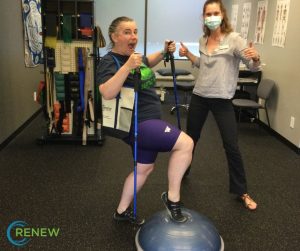
This summer, many of us are packing up the car or boarding an airplane to travel to new places, have fun, and create lasting memories. However, for those dealing with chronic pain or physical limitations, travel can also present challenges and concerns about potential flare-ups.
Whether you’re an avid traveler or have an upcoming trip planned, it’s crucial to prioritize your health and well-being while on the road or sitting for long periods of time. At Renew Physical Therapy, we understand the importance of maintaining your physical health, even when traveling.
This month, we sat down with Erin Heard, PT, DPT at Renew Physical Therapy at the Renton clinic who shares tips and advice on how to travel without worsening existing conditions or triggering discomfort.
Q: What is my body experiencing when I have a flare-up?
A: A flare-up is a temporary increase of your symptoms as a result of doing some type of activity that is different from your usual routine. Traveling can involve sitting for longer periods of time in different seats, an increase of walking on unfamiliar terrain, and also often includes carrying and lifting bags and supplies. All of these can put stress on your muscles and joints that are outside the typical strain of your day.
Q: What specific activities or movements should I be cautious about while traveling to prevent flare-ups?
A: When you are lifting bags to load into a car or into an overhead bin of an airplane, make sure you use proper body mechanics, engage your core muscles, and avoid letting your back round or arch excessively.
If you are traveling with people or pets in the backseat, be careful about the amount of time you spend turning around to look backwards.
Although sleeping can be a challenge while traveling, consider how you are supporting your head and neck to avoid spending prolonged time with your head positioned too far to the side or downwards.
Q: What are some recommended exercises or stretches that I can do before and during a trip to help minimize the risk of flare-ups?
A: The best thing you can do is to move your body frequently throughout your travels. Try out some of the following exercises to keep your muscles active and joints moving smoothly.
- Head Rotation: Turn your head slowly side to side while you sit with upright posture.
- Shoulder Rolls: Move both shoulders up, back, and down in small circles.
- Chest Opener: Reach both arms out in a T-shape with palms upwards and stretch them backwards.
- Spinal Twist: In sitting or standing position, turn your shoulders to look behind you to the left, then right.
- Hip Flexor Stretch: Stand in a lunge position with front knee slightly bent. Push hips forward to feel stretch in the front of your hip.
Q: How can I ensure proper posture and body mechanics while sitting for extended periods during travel?
A: If you are traveling in your own vehicle, you can bring a cushion or a rolled-up bath towel to place behind your low back to keep your lumbar spine in a neutral alignment. When on a plane, a rolled-up jacket or coat can help fill the space behind your low back without adding to your luggage.
If you can adjust your car seat, aim for your hips to be slightly higher than your knees to prevent hip pain or low back tension.
When watching something on your phone or tablet, try to prop your screen at eye-height to prevent looking downwards for long periods of time.
To learn more or book an appointment with a Renew physical therapist, please visit our website at renew-physicaltherapy.com.


